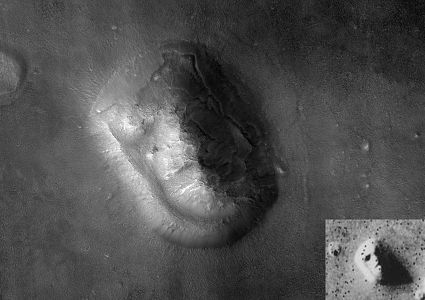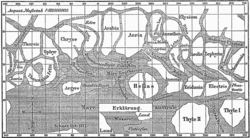Robert Zubrin
| |
|---|---|

Photo of Zubrin by the Mars Society
| |
| Born | April 9, 1952 |
| Nationality | American |
| Alma mater | University of Rochester (B.A) University of Washington (M.S), (PhD) |
| Known for | Mars Direct Mars Society The Case for Mars Energy Victory |
| Scientific career | |
| Fields | Aerospace engineering |
| Institutions | Martin Marietta Pioneer Astronautics |
Robert Zubrin is an American aerospace engineer and author, best known for his advocacy of human exploration of Mars. He and his colleague at Martin Marietta, David Baker, were the driving force behind Mars Direct, a proposal in a 1990 research paper intended to produce significant reductions in the cost and complexity of such a mission. The key idea was to use the Martian atmosphere to produce oxygen, water, and rocket propellant for the surface stay and return journey. A modified version of the plan was subsequently adopted by NASA as their "design reference mission". He questions the delay and cost-to-benefit ratio of first establishing a base or outpost on an asteroid or another Apollo program-like return to the Moon, as neither would be able to provide all of its own oxygen, water, or energy; these resources are producible on Mars, and he expects people would be there thereafter.
Disappointed with the lack of interest from government in Mars exploration and after the success of his book The Case for Mars (1996), as well as leadership experience at the National Space Society, Zubrin established the Mars Society in 1998. This is an international organization advocating a human mission to Mars as a goal, by private funding if possible.
Early life
Robert Zubrin was born in Brooklyn, New York on Apr 9, 1952. He was a science teacher for 7 years before becoming an engineer.
Qualifications and professional experience
Zubrin holds a B.A. in Mathematics from the University of Rochester (1974), a M.S. in Nuclear Engineering (1984), a M.S. in Aeronautics and Astronautics (1986), and a Ph.D. in Nuclear Engineering (1992) — all from the University of Washington. He has developed a number of concepts for space propulsion and exploration, and is the author of over 200 technical and non-technical papers and several books. He was a member of Lockheed Martin's scenario development team charged with developing strategies for space exploration.
He was also "a senior engineer with the Martin Marietta Astronautics
company, working as one of its leaders in development of advanced
concepts for interplanetary missions".
He is also President of both the Mars Society and Pioneer Astronautics,
a private company that does research and development on innovative
aerospace technologies. Zubrin is the co-inventor on a U.S. design
patent and a U.S. utility patent on a hybrid rocket/airplane, and on a
U.S. utility patent on an oxygen supply system (see links below). He was
awarded his first patent at age 20 in 1972 for Three Player Chess. His inventions also include the nuclear salt-water rocket and co-inventor (with Dana Andrews) of the magnetic sail. Zubrin is fellow at Center for Security Policy.
Pioneer Energy
In 2008, Zubrin founded Pioneer Energy, a research and development firm headquartered in Lakewood, Colorado. The company's focus is to develop mobile Enhanced Oil Recovery
(EOR) systems that can enable CO2-based EOR for both small and large
oil producers in the United States. The company has also developed a
number of new processes for manufacturing synthetic fuels.
Books
- The Case for Mars: The Plan to Settle the Red Planet and Why We Must (1996), with Richard Wagner. This outlines the Mars Direct plan along with speculation about the economic, social and technical viability of future Mars colonization. Revised and updated in 2011.
- Entering Space: Creating a Spacefaring Civilization (1999). This ranges from the current status quo and innovative startups of the aerospace industry, through exploration and colonization of Mars, to a more futuristic look at humanity's possible colonization of the solar system and the feasibility of interstellar travel with known physics.
- Mars On Earth: The Adventures of Space Pioneers in the High Arctic (2003). Zubrin recounts the origins and progress of the Mars Society's Mars Analog Research Station project, including a variety of perils, both mundane and adventurous, that were overcome in establishing the first analog Mars habitat on Devon Island in the high Arctic. He offers highlights of what has been learned so far through that effort.
- First Landing (2001), a hard science fiction novel about a future Mars flight using the Mars Direct plan.
- The Holy Land (2003). This is an "SF satire on the Middle East crisis and the War on Terrorism, and concerns what happens when the liberal Western Galactic Empire relocates the oppressed Minervan sect to their ancient homeland of Kennewick, Washington, in the midst of a United States ruled by Christian fundamentalist fanatics". The story was partly inspired by Čapek's War with the Newts.
- Benedict Arnold: A Drama of the American Revolution in Five Acts (2005). This is an effort to humanize and show the multiple dimensions of Benedict Arnold, and to contrast the democratic values embodied in the spirit of the Revolution with the socially bankrupt classism embodied in the British subjects who won Arnold to their side.
- Energy Victory: Winning the War on Terror by Breaking Free of Oil (2007). An expansion on his recent articles criticizing both reliance on oil and the potential for hydrogen energy, while highlighting the benefits of switching more toward methanol and ethanol. It carries an endorsement from former CIA director James Woolsey.
- How to Live on Mars (2008). A tongue-in-cheek technically accurate guidebook for Mars-bound Earthlings about how to survive and thrive on the Red Planet, written from the point of view of a 22nd-century Mars native.
- Merchants of Despair: Radical Environmentalists, Criminal Pseudo-Scientists, and the Fatal Cult of Antihumanism (2011). This traces the history of antihumanism over the last two centuries, from Thomas Malthus and the eugenics movement through to the anti-nuclear and global warming campaigns. Zubrin argues that these movements have all represented an attempt to gain oppressive political control through the restriction of human activities and freedom.
- Mars Direct: Space Exploration, the Red Planet, and the Human Future (2013). This e-book looks at the current situation of NASA and outlines a Mars Direct mission proposal with the SpaceX Dragon, and considers the implications of interplanetary exploration for humanity.
- The Case for Space: How the Revolution in Spaceflight Opens Up a Future of Limitless Possibility Prometheus Books (2019)
Books edited or co-authored
Zubrin has also edited or co-edited the following books, most of which include his contributions:
- Mars Direct: A Simple, Robust, and Cost Effective Architecture for the Space Exploration Initiative (1991), co-edited by D.A.V.I.D. Baker and Owen Gwyne. This contains a series of rationales and data regarding the proposal of plan Mars Direct.
- Islands in the Sky: Bold New Ideas for Colonizing Space (1996), co-edited with Stanley Schmidt. This is a collection of fifteen selected non-fiction entries that had been published in Analog magazine over the years; it includes five articles authored or co-authored by Zubrin, including "The Hypersonic Skyhook", "Mars Direct: A Proposal for the Rapid Exploration and Colonization of the Red Planet" (co-authored with David A. Baker), "Colonizing the Outer Solar System", "Terraforming Mars" (co-authored with Christopher McKay), and "The Magnetic Sail". Notable additional contributors include Robert L. Forward and the godfather of terraforming, Martyn J. Fogg, each of whom contributed two articles.
- From Imagination to Reality: Mars Exploration Studies of the Journal of the British Interplanetary Society : Precursors and Early Piloted Exploration Missions (1997).
- From Imagination to Reality: Mars Exploration Studies of the Journal of the British Interplanetary Society : Base Building, Colonization and Terraformation (1997).
- Proceedings of the Founding Convention of the Mars Society (1999), co-edited with Maggie Zubrin. This contains articles corresponding to talks presented at the founding convention of the Mars Society in Boulder, Colorado in August 1998; it includes contributions from Zubrin, Buzz Aldrin, Martyn Fogg, and many others.
- On to Mars: Colonizing a New World (2002 Apogee Books), co-edited with Frank Crossman. This contains articles corresponding to talks presented at the annual conventions of the Mars Society in Boulder in 1999, in Toronto, Ontario, Canada in 2000, and at Stanford University, Palo Alto, California in 2001.
- On to Mars 2: Exploring and Settling a New World (2005 Apogee Books), co-edited with Frank Crossman. This contains over 130 articles corresponding to talks presented at the annual conventions of the Mars Society in Boulder in 2002, in Eugene, Oregon in 2003, and in Chicago, Illinois in 2004.
The ethics of terraforming
Dr. Zubrin is known as an advocate of a moderately anthropocentric position in the ethics of terraforming. Discussions of the ethics of terraforming often make reference to a series of public debates Zubrin has held with his friend Christopher McKay, who advocates a moderately biocentric position on the ethics of terraforming. For example, a written account of some of these debates is available in On to Mars: Colonizing a New World, as a joint article, "Do Indigenous Martian Bacteria have Precedence over Human Exploration?" (pp. 177–182)
Cultural references
An aging Robert Zubrin also appears as a background character in The Martian Race (1999) by Gregory Benford,
a science fiction novel depicting early human explorers on Mars in the
very near future. Benford, who is also an astrophysicist, is a longtime
member of both the board of directors and the steering committee of the
Mars Society.
Robert Zubrin was also featured in a 2007 CBC Television documentary special, The Passionate Eye, dubbed "The Mars Underground".
The songwriter and musician Frank Black (alias Black Francis of the Pixies) penned an homage to Zubrin, "Robert Onion", on the album Dog in the Sand. The lyrics are in the form of an acrostic, spelling "Robert The Case For Mars Zubrin".
In 2010 Robert Zubrin was featured in the Symphony of Science video "The Case for Mars" along with Carl Sagan, Brian Cox, and Penelope Boston.
The fictional character Dr. Zachary Walzer in the 2010-11 independent VODO series Pioneer One was inspired by Zubrin.
In 2016, Zubrin was one of several scientists and engineers interviewed in the National Geographic miniseries Mars.
Patents
- U.S. design patent D405,750, "Reusable rocket airplane"
- U.S. Patent 6,119,985, "Reusable rocket-propelled high altitude airplane and method and apparatus for mid-air oxidizer transfer to said airplane"
- U.S. Patent 6,347,627, "Nitrous oxide based oxygen supply system"
- U.S. Patent 3,652,091, "Three-player chess board"












